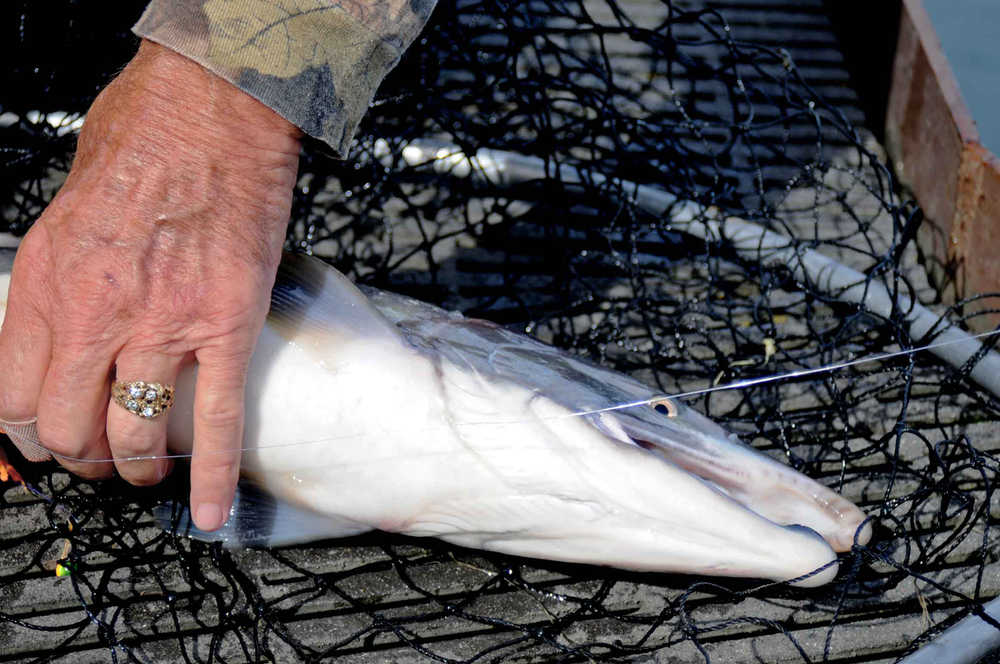Most of the catch to be found in the Kenai River at present is pink instead of silver.
Anglers on the fishing dock near the Soldotna Visitor’s Center on Wednesday around noon were hooking into pink salmon after pink salmon, getting a bite or snag every other cast or so. Most were still pinkish, starting to turn to spawning colors, but not all the way into their humpbacked phase yet.
Further down the river, anglers at Cunningham Park were waiting hopefully for a catch of silvers on Monday around mid-afternoon. A few lucky fishermen were able to play some silver salmon to the bank and go home with a decent catch, but most reported no luck with silvers for most of the day. Pinks, however, were reportedly plentiful.
That’s been the trend so far as the fishing season on the central Kenai Peninsula wends onward into September — silvers have been spare. Jason Pawluk, the acting area management biologist for the Alaska Department of Fish and Game’s Division of Sportfish in Soldotna, said the run appears to have peaked and is declining again.
“I was expecting catch rates to continue to increase last week, but instead they started decreasing,” Pawluk said. “We’re not anywhere near the abundance from last year.”
Silvers usually continue to move up into the river until late fall, sometimes even into late October. The silvers arriving in August tend to be tributary-bound spawners, which are usually smaller fish. The larger, mainstem-bound spawners will usually arrive in September, he said.
Silver salmon seem to be fewer all across Cook Inlet. Anglers had more of a challenge to find Seward’s famous silver salmon for its 61st annual Silver Salmon Derby, which ran from Aug. 13–21. The winner hauled in a 16.22 pound fish, with the top 10 fish all heavier than 14 pounds, according to the North Gulf Coast fishing report from Fish and Game. Anglers from boats have been having better luck than shore-based anglers, according to the report.
The fishing for silvers has been spotty in Lower Cook Inlet as well. Anglers have been reporting slow silver fishing, and the run is beginning to wind down. Part of it could be due to high water levels throughout the season, allowing the silver salmon to move up sooner into the roadside streams, where anglers are only allowed to fish in the lower approximately two miles of the streams, said Carol Kerkvliet, the area management biologist for the Division of Sportfish in Homer.
When water levels are low, silver salmon usually stack up in the lower river, waiting for the water to rise so they can move up into the river to spawn. Kerkvliet cited a weir count from 2004 on the Anchor River, when Fish and Game maintained a weir on that river for coho, showing that out of the total run of 5,728 fish, 3,666 of them moved up the river on Sept. 2 alone. In other years when the water is consistently higher throughout the season, such as 2010, passage through the weir will spike several times as the fish move up the river in waves.
“That pattern repeated itself time and time again for these fish,” she said.
Fishing for sockeye salmon is close to done on the Kenai River — a few anglers may still catch one or two, but most have moved up into the river to spawn. Anglers on the Russian River may still have a chance to catch some sockeye salmon there, with several hundred of the fish passing through the weir on Lower Russian Lake each day since Aug. 18. The late run so far is about on par with the 2015 run, if a little fewer, coming in at 34,673 As of Aug. 23 compared to 38,867 on the same date last year.
Fishing for resident species like rainbow trout and Dolly Varden will likely pick up as the fall goes on, Pawluk said.
“Right now, what people are really going to start … is bead fishing behind the spawning kings and the spawning sockeye,” he said.
Reach Elizabeth Earl at elizabeth.earl@peninsulaclarion.com.

